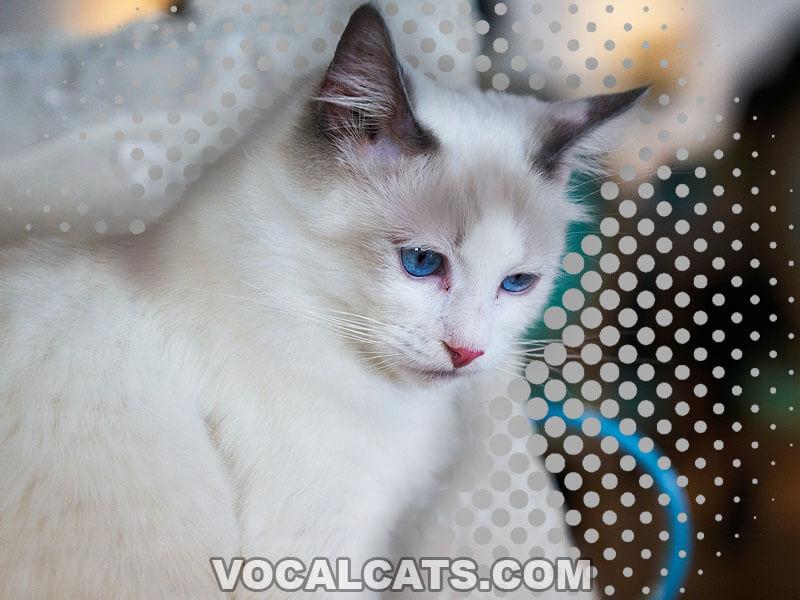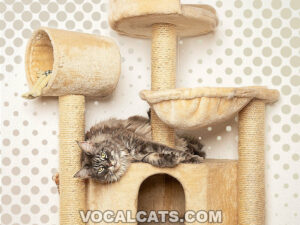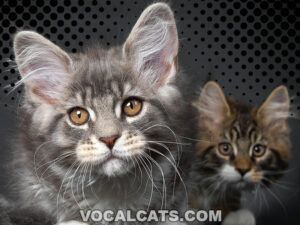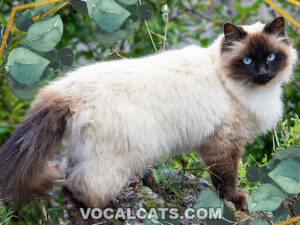The Ragdoll is one of the most beloved cat breeds in the world because of her plush coat and docile nature. Due to its popularity, it is inevitable that you will encounter Ragdoll mixed breeds that will tickle your fancy.
One of these is the Himalayan Ragdoll Cat. An interesting mix of the playfulness and easygoing qualities of the Ragdoll and Himalayan cats. This blue-eyed mixed breed is a recent addition to the growing number of Ragdoll mixed breeds.
Just like other Ragdoll mixed breeds, such as the Munchkin Ragdoll Cat, the Himalayan Ragdoll Cat will inherit the best attributes of each parent. In this comprehensive guide, we will discuss everything you need to know about the Ragdoll Himalayan Cat, including their temperament, common health issues, physical appearance, and dietary needs. We hope this guide will help you decide whether this mixed cat breed is the best feline companion for you and your family.
Contents
- Himalayan Ragdoll Cat: Breed overview
- What is a Himalayan Ragdoll?
- Ragdoll Himalayan Cat parent breeds
- Are Himalayan cats cuddly?
- Himalayan vs Ragdoll
- Which is better Himalayan or Ragdoll?
- Is the Himalayan Ragdoll Cat recognized by cat registries?
- Himalayan Cat Ragdoll physical appearance
- Himalayan Ragdoll size, height, and weight
- Himalayan Ragdoll Cat personality and temperament
- Do Ragdoll Himalayan make great family pets?
- Himalayan Ragdoll Mix Cat training
- Ragdoll Himalayan Cat Mix exercise requirement
- Himalayan x Ragdoll Cat grooming and cleaning
- Are Himalayan Ragdoll Cats hypoallergenic?
- Do Ragdoll Himalayan Cats shed?
- Ragdoll x Himalayan Cat food and diet
- Himalayan Ragdoll Cat common health issues
- How long do Himalayan Ragdoll Cats live?
- Ragdoll Himalayan Mix breeders
- Himalayan Ragdoll kittens
- Himalayan Ragdoll Cat price
- Finding a healthy Himalayan Ragdoll Cat for sale
- Places to find Himalayan Ragdoll Mix Kittens For Sale
- Mixed breeds similar to Himalayan Ragdoll Cat
- Himalayan Ragdoll Cat: Pros and Cons
- Is the Himalayan Ragdoll Cat right for me?
- Related Questions
Himalayan Ragdoll Cat: Breed overview
| Other names | Himalayan and Ragdoll Mix |
| Size | Medium – Large |
| Weight | 8 – 14 pounds |
| Height | 12 – 16 inches |
| Coat Colors | Seal, Blue, Red, Lilac, Cream, Chocolate |
| Child Friendliness | High |
| Feline Friendliness | High |
| Training Difficulty | Easy – Moderate |
| Grooming Upkeep | Moderate |
| Exercise Needs | Low |
| Health | Moderate |
| Lifespan | 12 – 18 years |
| Kitty Costs | $500 – $2,500 |
What is a Himalayan Ragdoll?
A Himalayan Ragdoll is a cross between the Himalayan and the Ragdoll cats. They possess the calm and docile quality of the Ragdoll and the silky Persian-like coat of the Himalayan.
Ragdoll Himalayan Cat parent breeds
The Ragdoll and the Himalayan share a lot of physical similarities, like their blue-colored eyes and point coloration, that it is can be difficult at times to distinguish between the two.
To learn about the Himalayan Cat mixed with Ragdoll, it would be useful to study each of their parent’s attributes that can be passed on to their offspring.
The Himalayan is a medium-sized cat with a pale coat on the body and dark-colored points in the extremities. Also known as a Himmy, their thick and double-coated coat makes them appear much larger than their actual body frame. They have a short body with heavy-boned legs and a thick, short neck. Their face can either have the Persian’s doll-like face or a more flattened look.
The Ragdoll is also a blue-eyed with a colorpoint coat. They are large cats with a long and rectangular body frame and a broad head that is equal on all sides as measured from the ear to the muzzle. Their silky coat consists of long guard hairs without any undercoat. Ragdolls are very docile and are often described as dog-like for being too clingy to their family.
You may be interested in: Blue Eyed White Ragdoll (Complete Guide)
Ragdoll history
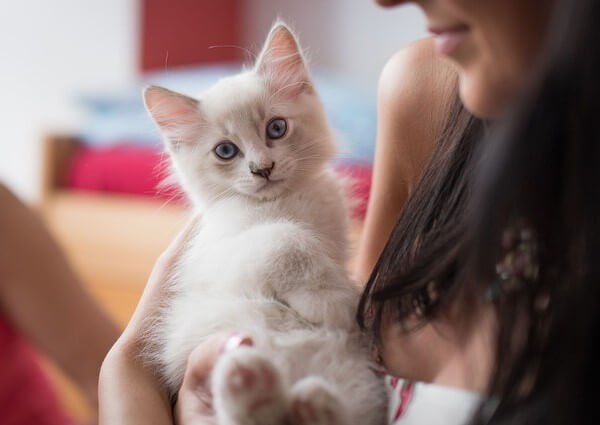
The Ragdoll was developed by Ann Baker in California during the 1960s from a long-haired domesticated cat named Josephine crossed with a number of Birman or Burmese type of cats. The offspring produced from these crosses have a unique and docile temperament with a penchant for going limp and relaxed or when held.
RELATED: British Shorthair Ragdoll Mix (Complete Guide)
Himalayan Cat history
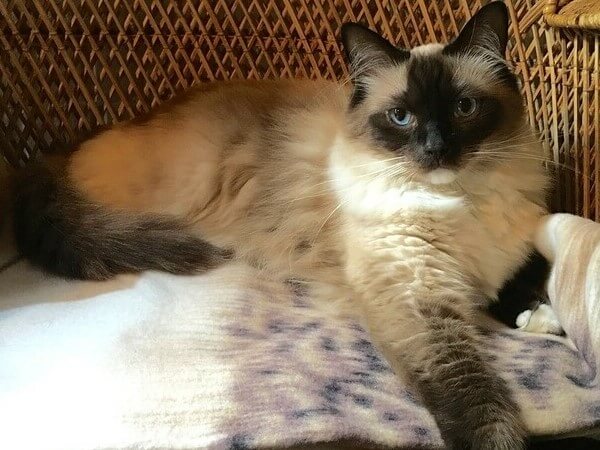
In the early part of the 20th century, several attempts were made to create a cat that possesses the Persian Cat’s body with the Siamese Cat’s coat markings. One of these was done by two medical researchers from Harvard that successfully created a long-haired Siamese.
Further efforts were made by an American breeder named Marguerita Goforth in the 1950s that led to the recognition of the Himalayan Cat by the Cat Fanciers’ Association (CFA).
In later years, the recognition was dropped and the Himalayan Cat was considered only a variation of the Persian Cat.
Are Himalayan cats cuddly?
Yes, the Himalayan cats are cuddly and highly affectionate that can quickly bond with their family. They love being lap cats that enjoy lounging around as much as the Ragdoll, but they can be moody at times and may sulk if they are not given the proper attention.
You may also like: Persian Ragdoll Cat (Complete Guide)
Himalayan vs Ragdoll
On the surface, the Himalayan and the Ragdoll look almost the same with their colorpoint coats and gentle personalities. This is why it’s easy for many to confuse the two breeds.
So, what is the difference between Himalayan and Ragdoll Cats?
The main difference between Himalayan Cat and Ragdoll Cat is that Himalayan Cat is double coated with a thick and fluffy undercoat while Ragdoll Cat only has a long but plush single coat.
Another difference between Ragdoll and Himalayan Cat is that Ragdolls are much larger than the Himalayan. Ragdolls averages 15 to 20 pounds while the Himalayan weighs between 6 and 12 pounds.
The Himalayan also appears to be more active and playful compared to the Ragdoll which is relaxed and more receptive to being carried around.
WANT MORE INFORMATION? Check out Ragdoll vs Himalayan: What’s The Difference? (With Pictures)
Which is better Himalayan or Ragdoll?
Both the Himalayan and Ragdoll make excellent pets and neither can be considered much better than the other. They look almost similar and are both very sweet-natured.
However, it is important to note that the Himalayan is less clingy and more independent than the Ragdoll which has a dog-like personality that loves to follow their families around.
The Ragdoll and the Himalayan are also both lazy. They both prefer a calm and quiet routine with the Himalayan having just a tad more energy.
Intelligence-wise, both can be taught tricks with ease, but the Ragdoll can be a bit more challenging to teach because of his more relaxed persona. You’ll just have to motivate them with more treats to keep them moving.
CHECK OUT: Are Ragdoll Cats Talkative Or Vocal?
Is the Himalayan Ragdoll Cat recognized by cat registries?
No, the Himalayan Ragdoll Cat is not recognized by cat registries because they are not purebred but rather designer cat breeds.
Himalayan Cat Ragdoll physical appearance
The Himalayan Ragdoll Cat may vary in appearance from each offspring in the litter since they are a mixed breed. Both parent breeds look almost similar to each other, especially with their blue-colored eyes and colorpoint coat patterns with only some slight differences in the facial features and body proportion.
So, what does a Ragdoll Cat look like and how does the Ragdoll Cat differ from the Himalayan?
The Ragdoll has a triangular-shaped face with oval eyes and medium-sized ears compared to the Himalayan’s rounder and flatter face.
In terms of body composition, both are heavy-boned, but the Himalayan is shorter in length and slightly taller with thick legs while the Ragdoll has a longer body with long legs.
The two parent breeds come in a variety of colors, such as seal, cream, chocolate, blue, lilac, and red.
READ ALSO: Seal Point Ragdoll (Complete Guide)
The Ragdoll can have three types of coat patterns, namely, colorpoint, mitted, and bicolor with variants of tortoiseshell or lynx.
The Himalayan, on the other hand, is also color-pointed with either a solid, lynx, or tortoiseshell pattern.
Himalayan Ragdoll size, height, and weight
The Himalayan Ragdoll cat is a medium to large cat. The length of their body in relation to their height depends on whose parent he took after.
| Height | Weight | |
| Male | 13 – 15 inches | 10 – 14 pounds |
| Female | 10 – 12 inches | 8 – 12 pounds |
Himalayan Ragdoll Cat personality and temperament
Both the Ragdoll and the Himalayan are friendly, gentle, and affectionate cats, so it would not be far-fetched that their offspring would have the same qualities. They love the company of their family and are known to be sociable.
Do Ragdoll Himalayan make great family pets?
Yes, Ragdoll Himalayan makes great family pets. In case you decide to take care of a Ragdoll Himalayan cat, all family members, whether young or old will enjoy the company of this cat breed. She is sweet, people-oriented and loves to be cuddled. Plus, she is not the jealous type, thus, she has no problem mingling with other pets in your home.
Himalayan Ragdoll Mix Cat training
Training a Himalayan Ragdoll mix is not a major problem. Of course, you have to be patient when it comes to teaching her how to use the litterbox. But, once she mastered it, you will not have any issues because she is an intelligent household pet.
Ragdoll Himalayan Cat Mix exercise requirement
The Ragdoll Himalayan cat mix is not a very active breed but she is playful. A simple and light 30-minute indoor activity or a game of fetch or chasing a laser light are good forms of exercise.
Avoid over-exerting her, more so if she inherited the brachycephalic features of her Himalayan parent.
Himalayan x Ragdoll Cat grooming and cleaning
Since a Himalayan x Ragdoll cat is a hybrid cat breed, the grooming requirements depend on which parent breed is more dominant. If she inherited the double coat of her Himalayan parent, brushing should be more frequent as compared to if she inherited the single coat of a Ragdoll cat.
Below is a table that will give you an idea of the grooming needs and frequency of a Himalayan Ragdoll Mix cat.
| Grooming Needs | Grooming Frequency |
| Hair Brushing | 3 – 4x weekly. |
| Nail Trimming | As needed. |
| Teeth Brushing | 2 -3x weekly. |
| Bathing | Once a month. |
| Eye Care | Check weekly. |
| Ear Care | Check weekly. |
Are Himalayan Ragdoll Cats hypoallergenic?
No, Himalayan Ragdoll Cats are not hypoallergenic. Dander and dirt can still attach to their loose furs which can eventually trigger allergic reactions in some people.
RECOMMENDED: Are Ragdoll Cats Hypoallergenic?
Do Ragdoll Himalayan Cats shed?
Yes, Ragdoll Himalayan Cats do shed throughout the year. However, single-coated Ragdoll Himalayan Cats will shed less than those with an undercoat.
Also, regardless of their coat type, climate type and seasonal changes play a major role in how much the cat will shed.
Ragdoll Himalayan Cats tend to have thicker fur during the winter and shed more during the summer. Cats who are also kept indoors more often tend to shed less because of the controlled temperature around the house and the artificial lighting.
RELATED: Do Ragdoll Cats Shed? 7 Ways To Shed Less!
Ragdoll x Himalayan Cat food and diet
Nutrition plays a huge role in the growth and maintenance of a Ragdoll x Himalayan cat. Unless specified by a veterinarian, your feline friend should receive her nutrients from high-quality cat food.
Essentially, the best cat food for your fuzzy friend must have a balance of the following:
- Water is the most vital component of cat food to avoid cats from getting dehydrated. This is the reason why we highly suggest wet or canned food over dry and kibble cat food. If you prefer to feed your furry friend the latter, it’s best to mix it with wet or canned food.
- Carbohydrates are where they get their source of energy. While there is no minimum required levels of carbohydrates, too much may increase your cat’s glucose levels.
- Proteins are necessary for the building, maintaining, and repairing of muscles and tissues.
- Fats are also good sources of energy. Plus, fats give insulation and protection to a cat’s body organs.
- Amino acids are also necessary for the absorption of proteins and help in muscle development and repair.
- Vitamins for protection against illnesses is necessary.
How much and how often should you feed your Ragdoll x Himalayan cat?
If she is still a kitten, give her ¼ to ½ cups of cat food, divided into 2 to 3 portions.
For adults, ½ to ¾ cups divided into 2 servings is our recommendation, unless she is diabetic or has other health issues.
If you’re still unsure, we highly recommend that you speak with your cat’s veterinarian as the vet knows your fuzzy friend the best and will know the best diet for him or her.
Himalayan Ragdoll Cat common health issues
Though cats are generally healthy animals, this does not mean that they are not susceptible to health problems.
Here are five (5) health issues that can affect your Himalayan Ragdoll Cat:
1. Polycystic Kidney Disease
A gene-related problem that is caused by small cysts that grow on the kidneys. For a lot of cats, the symptoms like excessive thirst begin to show at around the age of seven (7).
2. Feline Aortic Thromboembolism
This is a cardiovascular disease that is caused by a blood clot, thereby reducing the amount of blood flow and decreasing oxygen supply. The signs are paralysis and rapid breathing.
3. Hereditary Cataracts
Himalayan Ragdoll cats are prone to the juvenile development of cataracts, which usually begin to appear as early as three (3) months of age.
4. Respiratory Problems
If the Himalayan Ragdoll cat inherits the flat face of her Himalayan parent, she may be prone to breathing problems as a result of her brachycephalic facial structure. She can suffer from epiphora which is a condition that causes an abnormal overflow of tears from the eyes.
5. Feline Asthma
Himalayan cats are prone to feline asthma, the most common culprit of which are allergens such as pollen and household cleaners.
How long do Himalayan Ragdoll Cats live?
The average lifespan of a Himalayan Ragdoll cat is from 12 to 18 years.
Ragdoll Himalayan Mix breeders
If this is going to be your first time caring for a Himalayan Ragdoll kitten and you have no idea how to pick the right Himalayan Ragdoll kitten for you and your family, don’t worry! We’ve got you covered on what to look for when in search of breeders with Himalayan Ragdoll kittens.
Basically, there are about 15 questions that you need to clarify with the breeder of Ragdoll Himalayan kittens and these are the following:
- Ask the breeder if you can meet the parent cats. Try to observe if the parents are in good health and whether they are people-oriented.
- Ask if the parents of the kittens are certified-free or have been tested for some of the fatal gene-related diseases. Most of these health issues are inherited from the parents. Though there are no kittens that are 100% healthy but at least, try to avoid picking the kittens that tested positive for fatal diseases such as cardiovascular problems.
- Ask the breeder if the Himalayan Ragdoll kittens are properly-socialized, meaning, they are raised and allowed to mingle with other pets and people. In this way, you will bring home a well-adjusted Himalayan Ragdoll kitten who will not have any issues mingling with the rest of the family.
- Have the kittens received their core vaccinations?
- Have the kittens been dewormed?
- At what age can you take home the kitten with you? Take note that the best time is at 12 weeks of age.
- Are there kittens in the litter that are sick? If yes, what are their diagnosis as confirmed by the vet?
- Is there a kitten warranty and for how long?
- Can the breeder give you the names of their previous clients whom you can inquire about and ask for their personal reviews?
- Is there a sales contract?
- Has the kitten been neutered or spayed before you bring him or her home?
- What is the current food of the kittens?
- Is the breeder a member of any cat organization?
- How often is the queen or the mother cat bred in a year? A responsible breeder will not breed the queen each time she goes into the season because health is more important than profit.
- What kind of cat litter does the breeder use? Cats are creatures of habit so in case you’d use a different kind of litter from that of the breeder, it will take a while before your kitten adjusts to a new kind of cat litter.
Himalayan Ragdoll kittens
Ask the breeder if the Ragdoll Himalayan kittens are properly-socialized, meaning, are they raised and allowed to mingle with other pets and people. In this way, you will bring home a well-adjusted Himalayan Ragdoll kitten who will not have any issues mingling with the rest of the family.
It’s also good to know what are the types of food your Himalayan Ragdoll kitten should avoid. Some of the foods that are poisonous to our feline companions include onions, chocolates, and energy drinks, to name a few. This is to avoid kitten-poisoning.
Himalayan Ragdoll Cat price
The Ragdoll Himalayan Cat price can range from $500 to $2,500. The price depends on the color and the lineage. If you’re on a budget, you can choose to go to rescue centers where you can adopt or rescue a cat at a lower price.
Keep in mind that the purchase price of a Himalayan Ragdoll Cat is just the beginning. Having a cat comes with other on-going expenses, regardless of whether you got the cat from a breeder or from a rescue or adoption center.
So what are these expenses?
Take a look at the list below. Some of these are one-time expenses while the others are lifetime.
- Cat bed.
- Cat travel carrier.
- Litter box and litter.
- Cat toys.
- Collar and harness.
- Cat food and treats.
- Grooming tools.
- Semi-annual or annual veterinary expenses.
Finding a healthy Himalayan Ragdoll Cat for sale
Since this is a hybrid cat, the best place to find Ragdoll Himalayan Cat for sale is from reputable and ethical breeders of either a Himalayan cat or a Ragdoll cat. Below are some places where you may find Himalayan Ragdoll Cats for sale.
For sweet and adorable Himalayan Ragdoll cats for sale in the USA, go to Riverside Rags (riversiderags.com) located in Pasco, Washington. All the cats for sale come with The International Cat Association (TICA) and Cat Fancier’s Association (CFA) registration papers.
If you are in Australia, one of the best places to go is Aberlady Ragdolls (aberladyragdolls.com) in Wahroonga, Sydney. All the cats they use for breeding must first undergo genetic testing and all the kittens are raised inside their homes.
Places to find Himalayan Ragdoll Mix Kittens For Sale
If you’re in Canada, please visit the website of Dreamz Himalayans (dreamz-himalayans.com) where hopefully you can find your dream Himalayan Ragdoll kitten for sale.
Mixed breeds similar to Himalayan Ragdoll Cat
A Himalayan Ragdoll Mix cat is a fairly new designer cat breed. Its growing popularity among cat aficionados leads to the development of new mixes such as a Ragdoll Siamese Himalayan cat.
Ragdoll Siamese Ragdoll Himalayan Cat
A medium to large-sized mixed cat breed, a Ragdoll Siamese Himalayan wears a long and luscious coat that can come in various shades. This fuzzy friend is kid-friendly and loves to snuggle with his favorite people.
Himalayan Ragdoll Cat: Pros and Cons
While a Himalayan Ragdoll cat is a great family pet, not everything about her is rosy. In a nutshell, here is a table showing both the pros and the cons of taking care of this beautiful designer cat.
| Pros | Cons |
| Friendly to people and other pets. | Expensive to buy. |
| Loving and devoted. | Has the tendency to be chatty. |
| Good pets for kids. | Tend to suffer from breathing disorders. |
| Stunning appearance. | Moderate shedder. |
| Comes in many coat color combination. | Not suitable for allergy-sufferers. |
| Long lifespan. | May incur high veterinary costs. |
Is the Himalayan Ragdoll Cat right for me?
Since a Himalayan Ragdoll is a crossbreed between two (2) loving and people-oriented cats, it is safe to assume that she will be an affectionate, playful, and a good playmate for children.
This cat can basically adapt to all kinds of people and their living environments, so if there is one thing you have to think about, it is the shedding issue. Otherwise, everyone in your family will enjoy the easy-going temperament of a Himalayan Ragdoll cat.
Related Questions
If you give a Ragdoll Himalayan cat a pleasant and safe environment, with proper nutrition, exercise, and veterinary care, you will enjoy her awesome company for 12 to 18 years.
DISCLAIMER: THIS WEBSITE DOES NOT PROVIDE MEDICAL ADVICE
The information, including but not limited to, text, graphics, images and other material contained on this website are for informational purposes only. No material on this site is intended to be a substitute for professional veterinary advice, diagnosis, or treatment. Always seek the advice of your veterinarian or other qualified health care provider with any questions you may have regarding a medical condition.
Resources:
https://en.wikipedia.org/wiki/Ragdoll
https://www.wikihow.com/Care-for-Himalayan-Cats
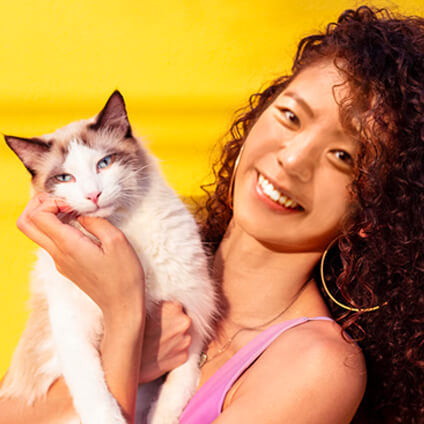
With over five years of specialized experience as an animal writer, my expertise lies in cat nutrition, health, behavior, grooming, and training. I am dedicated to delivering helpful and informative content that caters to the well-being of our feline friends. My primary goal is to empower pet owners with knowledge and ensure our feline companions thrive in health and happiness. In my free time, I love volunteering at local cat rescue centers.
